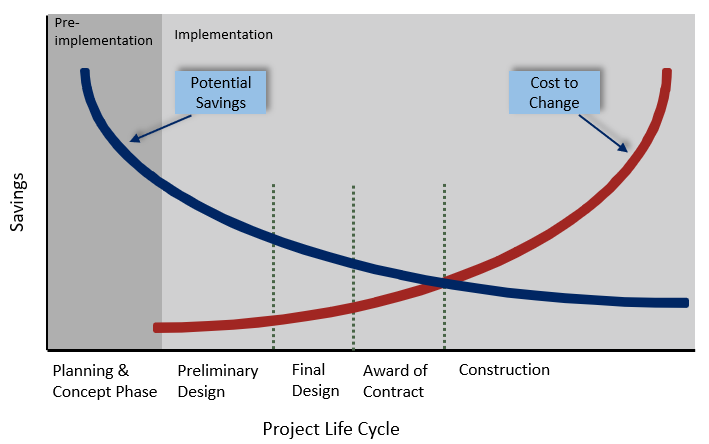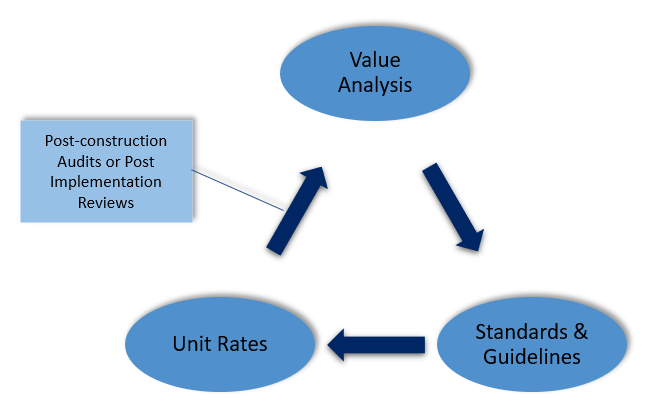Capital Asset Management Framework: 9. Budget & Cost Management
9.1 Introduction
Sound fiscal management is a fundamental principle of the Capital Asset Management Framework. Agencies must identify, analyze and manage costs effectively throughout the life cycle of capital assets, ensuring that spending does not exceed fiscal limits.
Adequate project budgets must be developed to meet functional specifications and carry a project through to completion. However, due to the nature of the capital planning and approval process, often this must be done before the design phase without the benefit of detailed design information.
To help agencies meet this challenge of calculating a project budget in the planning stage and manage project costs successfully through the design phase, the following chapter describes a series of tools and techniques for:
- developing clear and fixed functional program specifications prior to the design phase
- translating functional specifications into meaningful budget requirements, and
- securing unbiased cost management advice during planning and implementation from qualified professionals such as quantity surveyors
These tools should be applied to all projects regardless of the procurement method (include reference to appropriate section in Procurement chapter).
These techniques are applicable to projects that are procured through traditional methods as the risks related to budget, design, construction and operations reside with the agency and, by extension, the Province.
For alternatively financed projects, these risks are generally assumed by the private-sector developer, owner or financier and, while the extent to which this occurs depends on the model employed (e.g. build-own-operate-transfer), the tools described in this chapter remain relevant. They can be used to establish initial project scopes and budgets, and to establish benchmarks for measuring value for money.
For example, agencies can use unit rate cost models to establish Public Sector Comparators to assess the relative value for money associated with alternative procurement proposals. They can also use such things as space, design and technical standards to help determine service specifications for inclusion in Requests for Proposals or performance contracts with private-sector partners.
9.2 Budget & Cost Management Guidelines
Agencies are encouraged to develop internal policies (e.g. a cost management framework) to assist in developing adequate project budgets and managing project costs.
In doing this work, agencies should strive to ensure that:
- project budgets provide sufficient funding to reliably meet infrastructure and/or program needs
- project designs fulfil functional, technical and program requirements for the least life- cycle cost, and
- consistent quality and value are achieved across similar assets and/or program space
9.2.1 Budgeting Tools
To support budgeting and cost management processes, agencies should apply a system of planning and budgeting tools to estimate and control the quantity and quality of assets needed to meet service delivery needs. Several commonly used tools are described in the following sections.
9.2.1.1 Functional Programs or Requirements
A functional program is a document, typically prepared by a professional space planner during the pre-design phase, which describes the proposed services to be addressed in a capital project in sufficient detail to initiate schematic design. Functional programs are drafted in consultation with facility staff, administrators and design professionals, who translate service methods, systems, functional operations, organization and staffing considerations into specific requirements.
Design teams use functional programs to design and engineer projects to meet an agency’s needs including details of the project’s scope, in combination with space, design and technical standards.
9.2.1.2 Space, Design and Technical Standards
Space standards define the area required and allocated to meet a facility’s functional needs. Design standards apply to the efficiency, form or image of the space required.Technical standards are guidelines for the quantity and quality of material and systems used in construction.
Together, these standards can provide a framework for determining the quantity, quality and attributes of physical space required for service delivery, typically based on a functional program as described in Section 9.2.1.1.
Agencies are encouraged to develop space, design and technical standards to ensure that:
- functional program needs are reliably met
- similar types of program space are consistent across the province
- the project uses systems and materials with proven superior technical and life-cycle cost performance, and
- design and technical assumptions underlying project budgets (i.e. unit rates) are articulated and understood
For agencies pursuing alternative procurement strategies, space, design and technical standards can be used to help determine service specifications for inclusion in Requests for Proposals or performance contracts with private-sector partners.
Standards must be maintained and updated as needed to ensure they adequately reflect desired program outcomes and specifications. Updates should be based on information gathered through post-implementation reviews and value analysis sessions.
9.2.1.3 Other Budgeting Tools
Unit rate/area costs (e.g. cost per square metre) can be used to determine the maximum cost of a new capital project or project component.
Per service unit costs (e.g. cost per patient bed day) can be used to determine both operating and capital costs for each unit of service delivery.
Per diem rates (e.g. the per-day cost to operate an asset) can be used to support trade-offs between operating and capital costs to deliver the most cost-effective solution.
In all three examples above, the unit or per diem rates must be based on design and program solutions that have proven their value for money over time. Used in combination with acceptable area and service standards, unit rate modelling can be an effective tool for establishing rational, equitable project budgets across like facility types or program functions.
In addition, these are examples of critical tools that can be used to assess value for money of alternative delivery strategies.
9.2.2 Cost Management Advice
As part of their cost management strategies, agencies should consider hiring professionals such as a quantity surveyor. A quantity surveyor can offer a range of expertise e.g. provide milestone cost estimates, devise tender strategies and fulfil monitoring and reporting requirements, as well as providing ongoing cost management advice at every stage of a project. They can also help agencies prepare project budgeting tools.
9.2.3 Value Analysis
Project design is a complex process that often requires agencies to make trade-offs between functional elements, building materials, design elements and aesthetics in order to stay within their budgets. The process of Value Analysis (VA) can support this decision-making by helping agencies systematically review their design decisions and assumptions to ensure they meet their value objectives. To assist in the process, agencies may retain professionals (e.g. quantity surveyors) trained in VA facilitation.
During value analysis, an agency reviews the scope, design and material components of a capital project (and, where appropriate, the operating equipment), and evaluates these elements against the project’s intended function. Alternatives are identified and evaluated from the perspectives of cost, reliability, performance and other requirements, and the agency chooses the options that offer the best value for money. Unlike cost-reduction analysis, value analysis provides a methodology for identifying major savings in a facility without reducing reliability or performance.
As illustrated below, applying value analysis concepts early in the planning phase can generate greater potential savings at a lower cost. VA results can also be used in aggregate to better inform standards and unit rate budgeting models.

9.2.4 A Sample Framework For Managing Costs
Figure 9.2.4. illustrates the integrated approach that some ministries use to manage the costs of capital projects. The framework ensures the results of project value analyses are incorporated into design guidelines which, in turn, are reflected in the unit rates used to establish project budgets.
Figure 9.2.4: Sample Cost Control Framework

Post-construction audits or post-implementation reviews monitor the effectiveness of facility/program standards and unit rates, project by project. In this way, decisions made through value analysis inform design and technical standards, and the related unit rates. Also, ensuring that framework adequately reflects program, technology and cost changes over time.
8. Budget & Cost Management < Previous | Next > 10. Reporting & Monitoring
